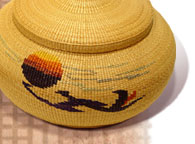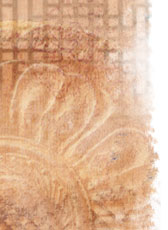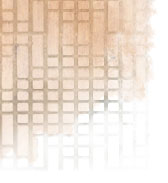time-consuming and difficult: all the stalks should be cut into several strips before boiling, and dried completely over several months. Then the strips are laid outside for approximately six days and nights to be dampened by dew and bleached by the sun’s rays. After this process is completed, the wancho strips attain the distinctive glossy white color and are ready to be woven. Today, there are two types of weaving: machine-weaving and hand-weaving. Square mats are normally woven by a machine, whereas round mats and other items are woven by hand. Yi Sang-jae, however, prefers hand-weaving regardless whether a mat is square or round. A beginner normally starts with making a small mat. It may look simple at first sight, but the key is, as stated before, to employ both patience and deft fingers. Many try the art of wancho weaving but most give up within less than a year of beginning. It may be appropriate, then, as well as Korean art connoisseurs. His pieces were even exhibited by a museum in Britain, with help from an Anglican missionary. The widespread reputation of his art is a result of his superior skill and most critics are generous in their praise of him. The following passage was taken from a report prepared before his art was designated as an Important Intangible Cultural Property: “Yi Sang-jae’s wancho art, accomplished after four decades of experience, is extraordinary. In his work, all the stripes are evenly woven, in good order and beautiful. The patterns of characters, flowers and cranes dotted around are nicely arranged to form a good natural composition. One of the greatest things of his art that excels others is that the front and back of a woven work is correctly matched.” Yi assures us that he has never been bored with the form, color and texture of his works although he dedicated most of his life to the art of wancho weaving. That is why he looks so happy in his workshop weaving a new piece as if he is weaving the Korean tradition strip by strip. View the master's works |
||||||||||
|



















